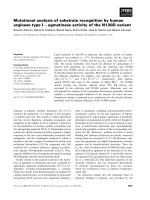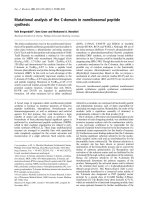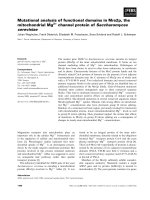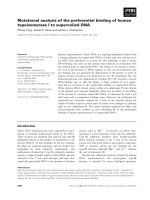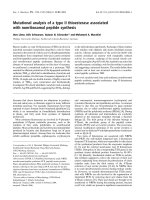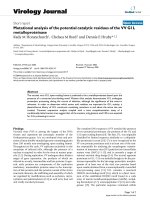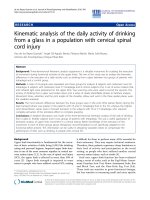báo cáo hóa học:"Mutational analysis of the potential catalytic residues of the VV G1L metalloproteinase" docx
Bạn đang xem bản rút gọn của tài liệu. Xem và tải ngay bản đầy đủ của tài liệu tại đây (537.11 KB, 7 trang )
BioMed Central
Page 1 of 7
(page number not for citation purposes)
Virology Journal
Open Access
Short report
Mutational analysis of the potential catalytic residues of the VV G1L
metalloproteinase
Kady M Honeychurch
1
, Chelsea M Byrd
2
and Dennis E Hruby*
1,2
Address:
1
Department of Microbiology, Oregon State University, Corvallis, Oregon 97331, USA and
2
SIGA Technologies, Inc, Corvallis, Oregon
97333, USA
Email: Kady M Honeychurch - ; Chelsea M Byrd - ; Dennis E Hruby* -
* Corresponding author
Abstract
The vaccinia virus G1L open-reading frame is predicted to be a metalloproteinase based upon the
presence of a conserved zinc-binding motif. Western blot analysis demonstrates G1L undergoes
proteolytic processing during the course of infection, although the significance of this event is
unknown. In order to determine which amino acid residues are important for G1L activity, a
plasmid-borne library of G1L constructs containing mutations in and about the active site was
created. Transient expression analysis coupled with a trans complementation assay of a
conditionally-lethal mutant virus suggest that, of the mutants, only glutamic acid 120 is non-essential
for G1L processing to occur.
Findings
Vaccinia virus (VV) is among the largest of the DNA
viruses and represents the prototypic member of the
Orthopoxvirus genus. It is an enveloped virus and pos-
sesses a linear double-stranded genome containing greater
than 200 mostly non-overlapping open reading frames.
Throughout its life cycle, VV replicates exclusively in the
cytoplasm of infected cells, although the presence of a
nucleus is required in order for the virus to mature prop-
erly [1,2]. During replication, VV undergoes three distinct
stages of gene expression, the products of which are
referred to as early, intermediate and late proteins. In gen-
eral, early proteins are components of the replication
machinery, intermediate proteins assist in the transcrip-
tion of late proteins and late proteins consist of the virion
structural elements, the trafficking and assembly of which
are regulated by modifications such as acylation, myris-
toylation and palmitoylation [3-8] as well as by host cell
and virally encoded proteases.
The complete DNA sequence of VV revealed the presence
of two potential proteinases, the products of the I7L and
G1L open reading frames [9]. The first, I7L, was originally
identified by limited sequence similarity to a ubiquitin-
like proteinase in yeast [10]. I7L is now recognized as the
VV core protein proteinase and is at least one of the enti-
ties responsible for initiating the morphogenic transfor-
mation of immature virus (IV) particles into intracellular
mature virus (IMV) [11-13] and is currently a target of
rational antiviral drug design [14]. The second apparent
proteinase is G1L. G1L was initially thought to be the pro-
teinase responsible for the late-stage proteolytic morpho-
genesis of at least one of the viral core proteins based
upon results obtained from a transcriptionally controlled
trans-processing assay [15] G1L contains a canonical
HXXEH zinc-binding motif [16], which is a direct inver-
sion of the established HEXXH motif found in a wide
array of matrix metalloendopeptidases (MMPs), includ-
ing thermolysin [17], aminopeptidase N [18] and colla-
genase [19]. The particular sequence contained within
Published: 27 February 2006
Virology Journal2006, 3:7 doi:10.1186/1743-422X-3-7
Received: 17 January 2006
Accepted: 27 February 2006
This article is available from: />© 2006Honeychurch et al; licensee BioMed Central Ltd.
This is an Open Access article distributed under the terms of the Creative Commons Attribution License ( />),
which permits unrestricted use, distribution, and reproduction in any medium, provided the original work is properly cited.
Virology Journal 2006, 3:7 />Page 2 of 7
(page number not for citation purposes)
G1L is characteristic of the M16 (pitrilysin) family of
MMPs as well as a variety of proteins found in bacteria
and yeast (Fig. 1A). Most known MMPs include a signal
sequence to allow for secretion, an inhibitory pro-
sequence to regulate activity and a catalytic domain con-
taining a catalytically active Zn
2+
ion [20]. Amino acid
sequence analysis demonstrated very little similarity
between G1L and other MMPs, aside from the presence of
a potential zinc-binding motif. However, computational
modeling has revealed that structurally, G1L appears to
contain a significant likeness to the β-subunit of the yeast
mitochondrial processing peptidase (MPP), which is the
(A) Alignment of the VV G1L putative catalytic domain with the catalytic domain found throughout MMPsFigure 1
(A) Alignment of the VV G1L putative catalytic domain with the catalytic domain found throughout MMPs. (B) G1L mutant
library. Schematic of alanine substitutions within the G1L ORF. Each construct includes a C-terminal Flag epitope for detection
by Western blot analysis.
34/DEILGIAHLLEHLLISF
44/VKNNGTAHFLEHLAFKG
79/DER-GIAHLLEHMLFKG
38/NEIMGIAHMLEHLNFKS
97/PEIAGTAHLLEHMLFKG
38/NEIMGIAHMLEHLNFKS
54/NEVMGIAHMLEHL SF
76/YGETGMAHLLEHLLFKG
70/MNYLGLTHLLEHLIIFN
Putative metalloprotease G1L [Vaccinia virus]
Chain B, Yeast Mitochondrial Processing Peptidase
Insulinase-like peptidase M16 [Pelobacter propionicus]
Peptidase, M16 family [Campylobacter jejuni]
Hypothetical zinc protease [Leptospira interrogans]
Protease (pqqE) [Campylobacter coli]
Putative zinc protease [Helicobacter hepaticus]
Predicted Zn-dependent peptidases [Microbulbifer degradans]
Potential a-pheromone maturation protease [Candida albicans]
A
G1L (590 aa)
Flag
VV(WR) 30/ENDIDEILGIAHLLEHLLISF/50 107/HIKELENEYYFRNEVFH/123
H41A 30/ENDIDEILGIAA
LLEHLLISF/50 107/HIKELENEYYFRNEVFH/123
E44A 30/ENDIDEILGIAHLLA
HLLISF/50 107/HIKELENEYYFRNEVFH/123
E120A 30/ENDIDEILGIAHLLEHLLISF/50 107/HIKELENEYYFRNA
VFH/123
H45A 30/ENDIDEILGIAHLLEA
LLISF/50 107/HIKELENEYYFRNEVFH/123
E112A 30/ENDIDEILGIAHLLEHLLISF/50 107/HIKELANEYYFRNEVFH/123
E110A 30/ENDIDEILGIAHLLEHLLISF/50 107/HIKA
LENEYYFRNEVFH/123
E114A 30/ENDIDEILGIAHLLEHLLISF/50 107/HIKELENA
YYFRNEVFH/123
E35A 30/ENDIDA
ILGIAHLLEHLLISF/50 107/HIKELENEYYFRNEVFH/123
B
Virology Journal 2006, 3:7 />Page 3 of 7
(page number not for citation purposes)
closest structural homolog with an available X-ray struc-
ture [PDB:1hr9.b] (Fig. 2) [21,22]. The β-subunit of the
yeast enzyme is characterized by the presence of an
inverted zinc-binding motif, HXXEHX
n
E, where two histi-
dine residues and a distal glutamic acid (E) residue coor-
dinate a zinc cation [16,23,24]. The E residue within the
HXXEH motif is involved in peptide bond hydrolysis
through the activation of water [23,25]. The essential
downstream E residue for M16 MMPs is found within a
region containing several completely conserved E residues
[23]. Although G1L lacks an exact match to this region, it
does contain a region 65 residues downstream of the
HXXEH sequence consisting of ELENEX
5
E (residues 110
through 120) that is very highly conserved among poxvi-
ruses.
While it is tempting to predict that VV G1L behaves in a
manner similar to yeast MPP, the fact remains that very lit-
tle is actually known about G1L activity. Through the
development of a conditional-lethal recombinant vac-
cinia virus, G1L was identified as an essential component
of the VV replication cycle [26,27]. Conditional-mutants
grown under non-permissive conditions arrested their
replication subsequent to core protein cleavage but prior
to complete core condensation suggesting the major viral
proteins are expressed and processed independently of
G1L but that G1L plays a crucial role in the conversion of
vaccinia virus from immature virions into infectious IMV
particles [26-28]. Western blot analysis suggests G1L exists
initially as a 68 kDa entity, which may be cleaved into 46
kDa and 22 kDa products [26]; however, the significance
of this cleavage remains unclear. The presence of a bound
zinc ion has yet to be experimentally confirmed, although
efforts to obtain G1L in sufficient quantities and of suffi-
cient purity to allow for such analyses are currently under-
way.
In the present study, an analysis of the putative active site
of G1L was carried out in an attempt to understand which
amino acid residues are important for G1L processing as
well as which of the four downstream E residues present
within the highly conserved ELENEX
5
E sequence is likely
to participate in the coordination of a zinc ion if such an
interaction does in fact occur. Through the use of a library
of transiently expressed G1L mutants containing C-termi-
nal flag epitopes coupled with rescue analysis of a tetracy-
cline-dependent conditional-lethal mutant, the results
obtained suggest that only E120 can withstand mutation
and still produce a phenotype similar to what is observed
for wild type G1L.
The putative active site of VV G1L is thought to consist of
histidine (H) residues 41 and 45 and a downstream E, all
of which are thought to contribute to zinc-binding, and E
residue 44, which is predicted to participate in the hydrol-
ysis of the substrate peptide bond. In this study, each of
these residues was systematically mutated to alanine (A)
(Fig 1B). There are four candidate downstream E residues,
including E110, E112, E114 and E120. Computational
modeling utilizing the β subunit of the yeast MPP suggests
Homology model of G1L using the yeast MPP as a templateFigure 2
Homology model of G1L using the yeast MPP as a template. G1L is depicted as a ribbon colored by alignment: identical resi-
dues, green; similar residues, yellow; non-conserved residues, white; insertions, magenta; deletions, black. The MPP template is
shown as a thin yellow line. Active site residues are represented as thick sticks and the Zn
2+
ion as a cyan sphere. A substrate
peptide is shown as blue and red ribbon and thin sticks. (A) G1L in its entirety. (B) Close-up view of the putative active site res-
idues.
AB
Virology Journal 2006, 3:7 />Page 4 of 7
(page number not for citation purposes)
E110 is the downstream E residue involved in zinc coordi-
nation (Fig. 2). Mutation of E112 or E114 was shown to
abrogate the processing of p25K in a trans-processing
assay [15], although whether or not this result was an arti-
fact of the assay remains to be determined. The fact that
both E112 and E114 are very highly conserved through-
out the Orthopoxvirus genus as well as poxviruses in gen-
eral implies that at least one of them may be involved in
the activity of G1L. Glutamic acid residue 120 was selected
for mutation since its location 74 residues downstream
from the HXXEH motif follows the same pattern observed
for members of the zinc-dependent M16 family of metal-
loproteinases [29,30] as well as a variety of other metal-
loenzymes (Fig 1A). These enzymes are characterized by
an HXXEHX
74–76
E active site motif, a motif that could
apply to G1L if the zinc-binding downstream residue is
E120. E35, a highly conserved residue not predicted to
participate in the catalytic activity of G1L, was also
mutated in order to gain an understanding of the roles
played by other charged residues that surround the active
site. A study conducted by Kitada et al [23] demonstrated
that a conserved E residue just upstream of the active site
motif functioned as a necessary acidic residue since muta-
tional analysis demonstrated a loss of enzyme activity
upon the replacement of E47 with A but a partial restora-
tion of activity when an aspartic acid (D) was substituted
for E47. Each construct in this study was engineered with
a flag epitope (DYKDDDDK) on the C-terminus for detec-
tion in immunoblot analysis (Fig. 1B) and was placed
under the control of either the synthetic early-late pro-
moter [31], as in the case of constructs used in transient
expression assays, or the native G1L promoter, which is
located in the region 229 basepairs upstream of the G1L
initiating codon, for constructs employed in rescue assays.
Previous studies have demonstrated that during the VV
replication cycle G1L undergoes an internal cleavage event
[26]. At this point it remains unclear as to whether G1L
participates in autoproteolysis or exists as a substrate of
another viral or cellular proteinase. In an effort to get one
step closer to answering this question, the fate of the G1L
mutant plasmid library was analyzed in the context of a
VV infection. BSC
40
cells [1] were transfected with 1.5 µg
of plasmid DNA containing either wild type G1L or one of
the eight single-site mutants by way of a liposome-
dependent transfection procedure. Four hours later, the
transfection solution was removed and cells were infected
with VV strain Western Reserve (WR) at a multiplicity of
infection (MOI) of two. Twenty-four hours later, cells
were harvested and extracts were subjected to immunob-
lot analysis using anti-flag antisera. Results indicate that
in each case full length G1L is expressed at approximately
66 kDa as indicated by the arrow (Fig. 3, upper panel).
However, a cleaved product is only observed for wild type
G1L and G1L containing a mutation at E120. The mutant
construct E35A also appears to undergo some degree of
cleavage albeit to a much lesser extent (Fig. 3, lower
panel). Taken together, these results suggest that altera-
tions in the amino acid sequence of the putative active site
of G1L as well as three of the four potential downstream
zinc-binding residues renders the protein either unable to
perform autocatalysis or unrecognizable as a substrate for
G1L undergoes proteolytic processingFigure 3
G1L undergoes proteolytic processing. BSC
40
cells were transfected with 1.5 µg of plasmid DNA containing either wild type
G1L or one of the eight single-site mutants. Four hours later, the transfection solution was removed and cells were infected
with VV strain WR at an MOI of two. Twenty-four hours later, cells were harvested and extracts were subjected to Western
blot analysis with anti-Flag antisera. The top panel demonstrates full length G1L, indicated by the arrow, and the lower panel
shows the resulting cleavage products indicated by *.
Virology Journal 2006, 3:7 />Page 5 of 7
(page number not for citation purposes)
another proteinase. Additionally, these results imply that
E120 would not be the downstream residue involved in
the coordination of a zinc ion.
To determine the role of these conserved residues in G1L
activity, the mutant G1L constructs were evaluated for
their ability to rescue viral replication in a trans comple-
mentation assay utilizing a tetracycline (TET)-dependent
recombinant VV, vvtetO:G1L. The construction of
vvtetO:G1L is described in detail in 27. Briefly, the TET
operator was inserted directly upstream of the G1L open
reading frame. When used in conjunction with a commer-
cially available cell line expressing the TET repressor,
expression can be controlled by either the presence or
absence of TET within the culture media. In our assay,
TREx 293 cells (Invitrogen, Carlsbad, CA) were transfected
with 1 µg plasmid DNA bearing either wild type G1L or
one of the single-site mutants. Four hours later the trans-
fection solution was removed and replaced with infection
media containing vvtetO:G1L at an MOI of 0.1 Cells were
harvested at twenty-four hours post infection, subjected to
a series of rapid freeze/thaws to release intracellular virus
particles and titered by plaque assay on BSC
40
cells. Figure
4 shows the average percent rescue obtained for each of
the mutant constructs relative to wild type G1L and is the
culmination of two independent experiments. With the
exception of wild type G1L, the E120A mutant and, to a
lesser extent the E35A mutant, none of the other mutants
were capable of complimenting the conditional mutant
virus grown in the absence of TET. These results are in
accordance with what was observed in the transient
processing assay and suggest that cleavage of G1L is a nec-
essary event in order for VV to propagate efficiently. The
fact that the E35A construct conveys only partial rescue
correlates with the reduction in proteolysis observed by
immunoblot.
Mutational analysis of the putative catalytic and zinc-binding residues of G1L utilizing a trans complementation assayFigure 4
Mutational analysis of the putative catalytic and zinc-binding residues of G1L utilizing a trans complementation assay. TREx 293
cells were transfected with 1 µg plasmid DNA bearing either wild type G1L or one of the single-site mutants. Four hours later
the transfection solution was removed and replaced with infection media containing vvtetO:G1L at an MOI of 0.1 Cells were
harvested at twenty-four hours post infection, subjected to a series of rapid freeze/thaws and titered via plaque assay on BSC
40
cells. Bars represent the percent rescue of each construct relative to what was achieved by transfection with the wild type G1L
construct (G1L). Each transfection was carried out in the absence of TET (TET-).
Virology Journal 2006, 3:7 />Page 6 of 7
(page number not for citation purposes)
With the recent identification of I7L as the VV core protein
proteinase [11-13], the function of G1L within the viral
replication cycle remains an enigma. Initially, the core
proteinase was thought to be G1L due to discovery of an
HXXEH inverted zinc-binding motif common to mem-
bers of the M16 family of metalloproteinases (Fig. 1A).
This motif is 100% conserved among poxviruses implying
it is the enzyme active site. Additional sequence analysis
and structural modeling further support the hypothesis
that G1L may be the first example of a virally encoded
metalloenzyme, although, G1L has not yet been shown to
coordinate a zinc ion. To date, G1L expression is known
to be an essential part of a VV infection. It has also been
shown to undergo proteolytic processing, which appears
to be essential for activity.
In this manuscript we report on the analysis of eight
highly conserved residues within VV G1L including the
three conserved residues located within the HXXEH cata-
lytic motif as well as four downstream E residues, one of
which is believed to be the essential downstream residue
involved in the coordination of a zinc ion (Fig. 2). A
library of C-terminally flag-tagged G1L constructs con-
taining single point mutations to each residue was gener-
ated (Fig. 1B). Transient expression assays allowed us to
monitor the processing of each construct through the
detection of a C-terminal cleavage product. Cleavage was
observed for wild type G1L as well as the construct con-
taining a mutation to E120 (Fig. 3), however G1L
appeared unable to tolerate mutations in E110, E112 or
E114. Further, mutations in H41, E44 or H45 also inhib-
ited G1L processing. This may be indicative of either the
loss of a zinc ion, which would render a metalloprotein-
ase inactive or the destabilization of protein folding
resulting in the inability of G1L to be recognized as a sub-
strate. Interestingly, mutation of E35, a highly conserved
residue not predicted to participate in zinc-binding or
substrate association, appears to affect G1L activity as
well, although these effects were less dramatic than what
was observed for the other mutant constructs as evidenced
by the presence of a very faint C-terminal product. The
lack of a robust cleavage reaction suggests the presence of
an alanine at this position may destabilize the protein
structure enough to make processing inefficient. Further-
more, rescue of a conditionally lethal mutant virus grown
under non-permissive conditions was only observed with
the E120A mutant (Fig. 4), which produced a phenotype
nearly identical to the phenotype observed for wild type
G1L. The E35A mutant also demonstrated the ability to
rescue; however, rescue was markedly diminished relative
to wild type G1L. In no other case did rescue reach above
25% of wild type.
These results suggest that G1L may fit into the paradigm
of what is observed for other metalloproteinases and pro-
teolytic enzymes in general in that G1L may initially be
translated as an inactive zymogen, which is then activated
upon proteolysis. In the absence of G1L expression, arrest
in replication occurs subsequent to the activities of I7L,
but prior to complete core condensation [27] suggesting
the involvement of G1L in a proteolytic cascade. Of course
these data do not rule out the possibility that the process-
ing observed is simply an artifact of over-expression simi-
lar to what is observed for membrane-type-1 MMP, which
may undergo autoproteolysis to an inactive form as a
means of negative regulation in response to conditions of
over-expression [32]. This scenario is unlikely, however,
since the C-terminal region of G1L was observed via silver
stain in the context of a conditional mutant VV infection
[26].
The role of both the full-length and cleaved products of
VV G1L continue to be investigated as does the ability of
G1L to coordinate a zinc ion. If G1L is recognized as a
bona-fide metalloproteinase, it will be of interest to deter-
mine if it acts alone or has a requirement for an additional
subunit, much like what is observed for other MPPs. Fur-
ther, once an appropriate expression system is estab-
lished, analysis via mass spectroscopy may be used to
determine exactly where G1L cleavage occurs, which may
in turn aid in the identification of potential G1L sub-
strates.
Competing interests
The author(s) declare that there are no competing inter-
ests.
Authors' contributions
KMH conducted the experiments and wrote the manu-
script. CMB constructed the conditional lethal virus,
assisted with the creation of the figures and edited the
manuscript. DEH conceived the study, coordinated the
research efforts and edited the manuscript. All authors
read and approved of the final manuscript.
Acknowledgements
This work was supported by NIH research grant number AI-060160.
The authors would like to thank Seva Katritch for his assistance with the
computational modeling.
References
1. Hruby DE, Guarino LA, Kates JR: Vaccinia virus replication. I.
Requirement for the host cell nucleus. J Virol 1979, 29:705-715.
2. Hruby DE, Lynn DL, Kates JR: Vaccinia virus replication requires
active participation of the host cell transcriptional appara-
tus. PNAS 1979, 76:1887-1890.
3. Chen TF, Yoder JD, Hruby DE: Mass spectrometry analysis of
synthetically myristoylated peptides. Eur J Mass Spectrom 2004,
10:501-508.
4. Grosenbach DW, Hruby DE: Biology of vaccinia virus acylpro-
teins. Front Biosci 1998, 3:d354-364.
Publish with BioMed Central and every
scientist can read your work free of charge
"BioMed Central will be the most significant development for
disseminating the results of biomedical research in our lifetime."
Sir Paul Nurse, Cancer Research UK
Your research papers will be:
available free of charge to the entire biomedical community
peer reviewed and published immediately upon acceptance
cited in PubMed and archived on PubMed Central
yours — you keep the copyright
Submit your manuscript here:
/>BioMedcentral
Virology Journal 2006, 3:7 />Page 7 of 7
(page number not for citation purposes)
5. Grosenbach DW, Hansen SG, Hruby DE: Identification and anal-
ysis of vaccinia virus palmitylproteins. Virology 2000,
275:193-206.
6. Hansen SG, Grosenbach DW, Hruby DE: Analysis of the site
occupancy constraints of primary amino acid sequences in
the motif directing palmitylation of the vaccinia virus 37 kDa
envelope protein. Virology 1999, 254:124-137.
7. Martin KH, Franke CA, Hruby DE: Novel acylation of poxvirus A-
type inclusion proteins. Virus Res 1999, 60:147-157.
8. Yoder JD, Chen T, Hruby DE: Sequence-independent acylation
of the vaccinia virus A-type inclusion protein. Biochem 2004,
43:8297-8302.
9. Goebel SJ, Johnson GP, Perkus ME, Davis SW, Winslow JP, Paoletti E:
The complete DNA sequence of vaccinia virus. Virology 1990,
179:247-266. 517–563
10. Li SJ, Hochstrasser M: A new protease required for cell-cycle
progression in yeast. Nature 1999, 398:246-251.
11. Goldberg GI, Wilhelm SM, Kronberger A, Bauer EA, Grant GA, Eisen
AZ: Human fibroblast collagenase. Complete primary struc-
ture and homology to an oncogene transformation-induced
rat protein. J Biol Chem 1986, 261:6600-6605.
12. Byrd CM, Bolken TC, Hruby DE: The vaccinia virus I7L gene
product is the core protein protease. J Virol 2002,
76:8973-8976.
13. Byrd CM, Bolken TC, Hruby DE: Molecular dissection of the vac-
cinia virus I7L core protein proteinase. J Virol 2003,
77:11279-11283.
14. Byrd CM, Bolken TC, Mjalli AM, Arimilli MN, Andrews RC, Rothlein
R, Andrea T, Rao M, Owens KL, Hruby DE: New class of
orthopoxvirus antiviral drugs that block viral maturation. J
Virol 2004, 78:12147-12156.
15. Whithead SS, Hruby DE: A transcriptionally controlled trans -
processing assay: putative identification of a vaccinia virus-
encoded proteinase which cleaves precursor protein P25K. J
Virol 1994, 68:7603-7608.
16. Becker AB, Roth RA: An unusual active site identified in a fam-
ily of zinc metalloendopeptidases. Proc Natl Acad Sci U S A 1992,
89:3835-3839.
17. Kubo M, Imanaka T: Cloning and nucleotide sequence of the
highly thermostable neutral protease gene from Bacillus
stearothermophilus. J Gen Microbiol 1988, 134:1883-1892.
18. Olsen J, Cowell GM, Kønigshøfer E, Danielsen EM, Møller J, Laustsen
L, Hansen OC, Welinder KG, Engberg J, Hunziker W, Speiss M,
Sjöström H, Norén O: Complete amino acid sequence of
human intestinal aminopeptidase N as deduced from cloned
cDNA. FEBS Lett 1988, 238:307-314.
19. Goldberg GI, Wilhelm SM, Kronberger A, Bauer EA, Grant GA, Eisen
AZ: Human fibroblast collagenase. Complete primary struc-
ture and homology to an oncogene transformation-induced
rat protein. J Biol Chem 1986, 261:6600-6605.
20. John A, Tuszynski G: The role of matrix metalloproteases in
tumor angiogenesis and tumor metastasis. Pathology Oncology
Research 2001, 7:14-23.
21. Meijia Y, Jensen RE, Yaffe MP, Oppliger W, Schatz G: Import of pro-
teins into yeast mitochondria: the purified matrix processing
protease contains two subunits which are encoded by the
nuclear Mas1 and Mas2 genes. EMBO 1988, 7:3857-3862.
22. Taylor AB, Smith BS, Kitada S, Kojima K, Miyaura H, Otwinowski Z,
Ito A, Deisenhofer J: Crystal structures of mitochondrial
processing peptidase reveal the mode for specific cleavage of
import signal sequences. Structure 2001, 9:615-625.
23. Kitada S, Kojima K, Shimokata K, Ogishima T, Ito A: Glutamate res-
idues required for substrate binding and cleavage activity in
mitochondrial processing peptidase. J Biol Chem 1998,
273:32547-32553.
24. Kitada S, Yamasaki E, Kojima K, Ito A: Determination of the cleav-
age site of the presequence by mitochondrial processing
peptidase on the substrate binding scaffold and the multiple
subsites inside a molecular cavity. J Biol Chem 2003,
278:1879-1885.
25. Sternlicht MD, Werb Z: How matrix metalloproteinases regu-
late cell behavior. Annu Rev Cell Dev Biol 2001, 17:463-516.
26. Ansarah-Sobrinho C, Moss B: Vaccinia virus G1 protein, a pre-
dicted metalloprotease, is essential for morphogenesis of
infectious virions but not for cleavage of major core pro-
teins. J Virol 2004, 78:6855-6863.
27. Hedengren-Olcott , Marika , Byrd CM, Watson J, Hruby DE: The
vaccinia virus G1L putative metalloprotease is essential for
viral replication in vivo. J Virol 2004, 78:9947-9953.
28. Hedengren-Olcott , Marika , Hruby DE: Conditional expression of
vaccinia virus genes in mammalian cell lines expressing the
tetracycline repressor. J Virol Meth 2004, 120:9-12.
29. Affholter JA, Fried VA, Roth RA: Human insulin-degrading
enzyme shares structural and functional homologies with E.
coli protease III. Science 1988, 242:1415-1418.
30. Finch PW, Wilson RE, Brown K, Hickson ID, Emmerson PT: Com-
plete nucleotide sequence of the Escherichia coli ptr gene
encoding protease III. Nucleic Acids Res 1986, 14:7695-7703.
31. Chakrabarti S, Sisler JR, Moss B: Compact, synthetic vaccinia
virus early/late promoter for protein expression. Biotechniques
1997, 23:1094-1097.
32. Lehti K, Valtanen H, Wickström S, Lohi J, Keski-Oja J: Regulation of
membrane-type-1 matrix metalloproteinase activity by its
cytoplasmic domain. J Biol Chem 2000, 275:15006-15013.

